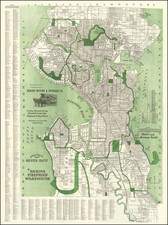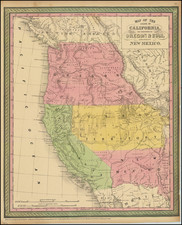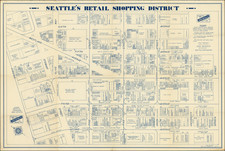George Davidson's Copy of The First Large Format Survey of Puget Sound
Rare thick paper separately published sea chart of Puget Sound, previously owned by George Davidson, including stamps showing the map as part of the Davidson Papers donated to the Bancroft Library. Also includes a withdrawn Stamp from the Bancroft.
This chart shows Puget Sound and spans from Olympia north to Utsalady on Camano Island. The sound is filled with islands, soundings, bottom types, ports, anchorages, inlets, and more. Seattle is named even though it was briefly disincorporated in 1867, the year the map is dated. The chart precedes the establishment of Tacoma. Numerous navigational notes appear, including tables on lighthouses and tides. Compiled and drawn by A. Lindenkohl.
George Davidson
George Davidson (1825 –1911) was a geodesist, astronomer, geographer, surveyor and engineer in the United States and one of the most important characters in the cartographic history of the West Coast of North America.
Davidson came to the U.S. in 1832 with his parents, who settled in Pennsylvania. He graduated at the Central High School in Philadelphia in 1845, standing first in his class. While a High School student, he had shown interest in scientific work, and had assisted Alexander D. Bache in his observations of the magnetic elements at Girard College. Upon his graduation in 1845, he began his career as clerk to Bache who was superintendent of the United States Coast Survey.
From 1846 to 1850, Davidson was occupied in geodetic field work, and in astronomy, serving in the different states on the east coast of the United States. In 1850, he went to California under the auspices of the Coast Survey, and was for several years engaged in the determination of the latitude and longitude of prominent capes, bays, etc., and of the magnetic elements of the Pacific Coast, reporting also upon the proper locations for lighthouses. His work included a survey of Washington and Puget sounds, and he had charge of the main triangulation of the coast in the region of San Francisco. In 1853, he named a number of mountains in the Olympic Mountains: he named Mount Ellinor for Ellinor Fauntleroy, who later became his wife, Mount Constance for Ellinor's older sister and The Brothers for her two brothers.
From 1861 until 1867, he was again on the Atlantic seaboard, principally engaged in engineering work on coast and river defences. At one time, he was in command of the Coast Survey steamer “Vixen,” and later performed astronomical work along the eastern coast.
In 1866, he became chief engineer of an expedition for the survey of a ship canal across the Isthmus of Darien. In 1867, he was appointed to make a special examination and report upon the geography and resources of Alaska, pending its purchase; his published report and conferences with congressional committees influenced the passage of the bill. He was placed in charge, during 1867, of the work of the Coast Survey on the Pacific, planned work for the land parties from 1868 until 1875, and inspected all the fields of work. He traveled extensively in Egypt, China, India and Europe, for purposes of scientific study.
From 1876 to 1886, he had charge of the main triangulation and astronomical work on the west coast; the records of the computing division showed that the results of his observations stood higher than any ever executed in America, Europe, or India, and they were characterized as “unique in the history of geodesy.” In 1881, Davidson twice measured the Yolo base line, one of the geodesic base lines that formed the foundation of triangulating distances in California. At that time, it was the longest base line yet attempted in trigonometrical operations, and the system of triangulation directly connected therewith was called in his honor the “Davidson quadrilaterals.”[2] He also measured the Los Angeles base line three times in 1888-1889. He retired from the Coast Survey in 1895, after 50 years of service.
He founded the Davidson Observatory in San Francisco, which was the first astronomical observatory on the Pacific coast of North America, and in 1869 brought the Pacific geodetic of the coast survey in telegraphic longitude connection with Greenwich. His astronomical work includes the observation of the total solar eclipse under the 60th parallel, in 1869; determination of the 120th meridian, in 1873; charge of the U. S. transit of Venus expedition, in 1874; recovery of the transit of Venus station of 1709 in Lower California occupied by Auteroche de la Chappe; observation of the total solar eclipse of January 7, 1880; and in 1882 charge of the party to observe the transit of Venus in New Mexico.
Other positions held by Davidson include president of the California Academy of Sciences from 1871 to 1887, Honorary Professor of Geodesy and Astronomy, and Regent of the University of California from 1877 to 1885. After his retirement from the Coast Survey, he became the first professor of geography at the University of California, Berkeley, and chaired that department from 1898 until his retirement in 1905, and remained an emeritus professor until his death. Davidson was one of 182 charter members of the Sierra Club in 1892 and served as a member of its board of directors from 1894 to 1910.
The United States Office of the Coast Survey began in 1807, when Thomas Jefferson founded the Survey of the Coast. However, the fledgling office was plagued by the War of 1812 and disagreements over whether it should be civilian or military controlled. The entity was re-founded in 1832 with Ferdinand Rudolph Hassler as its superintendent. Although a civilian agency, many military officers served the office; army officers tended to perform the topographic surveys, while naval officers conducted the hydrographic work.
The Survey’s history was greatly affected by larger events in American history. During the Civil War, while the agency was led by Alexander Dallas Bache (Benjamin Franklin’s grandson), the Survey provided the Union army with charts. Survey personnel accompanied blockading squadrons in the field, making new charts in the process.
After the Civil War, as the country was settled, the Coast Survey sent parties to make new maps, employing scientists and naturalists like John Muir and Louis Agassiz in the process. By 1926, the Survey expanded their purview further to include aeronautical charts. During the Great Depression, the Coast Survey employed over 10,000 people and in the Second World War the office oversaw the production of 100 million maps for the Allies. Since 1970, the Coastal and Geodetic Survey has formed part of the National Oceanic and Atmospheric Administration (NOAA) and it is still producing navigational products and services today.










![[Oregon Territory] Carte de l'Oregon (and) [Astoria Factory]](https://storage.googleapis.com/raremaps/img/small/77722.jpg)
![[ Seattle ] enjoy the beauty of Old Seattle and some of today's existing treasures](https://storage.googleapis.com/raremaps/img/small/69524.jpg)
![[British Columbia]. Routes of the Canadian Pacific Railway Company's Steamers British Columbia Coast Service](https://storage.googleapis.com/raremaps/img/small/83915.jpg)

